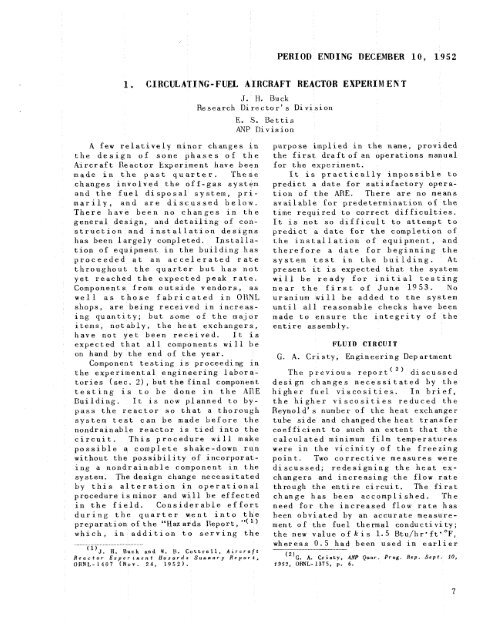the Molten Salt Energy Technologies Web Site
the Molten Salt Energy Technologies Web Site
the Molten Salt Energy Technologies Web Site
Create successful ePaper yourself
Turn your PDF publications into a flip-book with our unique Google optimized e-Paper software.
1. CIRCULATING-FUEL<br />
A few relatively minor changes in<br />
<strong>the</strong> design of some phases of <strong>the</strong><br />
Aircraft Reactor kxperiment have been<br />
made in <strong>the</strong> past quarter. These<br />
changes involved <strong>the</strong> off-gas system<br />
and <strong>the</strong> fuel disposal system, pri-<br />
marily, and are discussed below.<br />
There have been no changes in <strong>the</strong><br />
general design, and detailing of con-<br />
struction and installation designs<br />
has been largely completed. Installa-<br />
tion of equipment in <strong>the</strong> building has<br />
proceeded at an accelerated rate<br />
throughout <strong>the</strong> quarter but has not<br />
yet reached <strong>the</strong> expected peak rate.<br />
Components from outside vendors, as<br />
well as those fabricated in OMNL<br />
shops, are being received in increas-<br />
ing quantity; but some of <strong>the</strong> major<br />
items, notably, <strong>the</strong> heat exchangers,<br />
have not yet been received. It is<br />
expected that all components w i l l be<br />
on hand by <strong>the</strong> end of <strong>the</strong> year.<br />
Component testing is proceeding in<br />
<strong>the</strong> experimental engineering labora-<br />
tories (sec. 2) , but <strong>the</strong> final component<br />
testing is to be done in <strong>the</strong> ARE<br />
Building. It is now planned to by-<br />
pass <strong>the</strong> reactor so that a thorough<br />
system test can be made before <strong>the</strong><br />
nondrainable reactor is tied into <strong>the</strong><br />
circuit. This procedure w i l l make<br />
possible a complete shake-down run<br />
without <strong>the</strong> possibility of incorporat-<br />
ing a nondrainable component in <strong>the</strong><br />
system. The design change necessitated<br />
by this alteration in operational<br />
procedure isminor and will be effected<br />
in <strong>the</strong> field. Considerable effort<br />
during <strong>the</strong> quarter went into <strong>the</strong><br />
preparation of <strong>the</strong> “Hazards I’\eport, ”(’)<br />
which, in addition to serving <strong>the</strong><br />
.--... ... .-....... .-............ ............<br />
(”J. 8. Buck and W. B. Cottrell, Aircraft<br />
Reactor Erper irent Haxards Summary Report,<br />
ORNL-1407 (Nov. 24, 1952).<br />
PERIOD ENDING DECEMBER<br />
AIRCRAFT REACTOR EXPERIM ENT<br />
J. H. Buck<br />
Research Director’s Division<br />
E. S. Bettis<br />
A?P Division<br />
10, 1952<br />
purpose implied in <strong>the</strong> name, provided<br />
<strong>the</strong> first draft of an operations manual<br />
for t he e xp e r i men t .<br />
It is practically impossible to<br />
predict a date for satisfactory opera-<br />
tion of <strong>the</strong> ARE. There are no means<br />
available for predetermination of <strong>the</strong><br />
time required to correct difficulties.<br />
It is not so difficult to attempt to<br />
predict a date for <strong>the</strong> completion of<br />
<strong>the</strong> installation of equipment, and<br />
<strong>the</strong>refore a date for beginning <strong>the</strong><br />
system test in <strong>the</strong> building. At<br />
present it is expected that <strong>the</strong> system<br />
w i l l be ready for initial testing<br />
near <strong>the</strong> first of June 1953. No<br />
uranium w i l l be added to <strong>the</strong> system<br />
until all reasonable checks have been<br />
made to ensure <strong>the</strong> integrity of <strong>the</strong><br />
entire assembly.<br />
FLUID CIRCUIT<br />
G. A. Cri sty, Engineering Dep artment<br />
The previous report ( 2, discussed<br />
design changes necessitated by <strong>the</strong><br />
higher fuel viscosities. In brief,<br />
<strong>the</strong> higher viscosities reduced <strong>the</strong><br />
Reynold’s number of <strong>the</strong> heat exchanger<br />
tuhe side and changed <strong>the</strong> heat transfer<br />
coefficient to such an extent that <strong>the</strong><br />
c a1 c u l ated minimum fi 1 rn temperatures<br />
were in <strong>the</strong> vicinity of <strong>the</strong> freezing<br />
point. Two corrective measures were<br />
discussed; redesigning <strong>the</strong> heat ex-<br />
changers and increasing <strong>the</strong> flow rate<br />
through <strong>the</strong> entire circuit. The first<br />
change has been accomplished. The<br />
need for <strong>the</strong> increased flow rate has<br />
been obviated by an accurate measure-<br />
ment of <strong>the</strong> fuel <strong>the</strong>rmal conductivity;<br />
<strong>the</strong> new value of k i s 1.5 Btu/hr*ft’OF,<br />
whereas 0.5 had been used in earlier<br />
(2)G. A. Cristy, ANP Quar. Prag. Rep. Sept. 10,<br />
1959, OWL-1375, p. 64<br />
7



![Review of Molten Salt Reactor Physics Calculations [Disc 2]](https://img.yumpu.com/21979492/1/190x247/review-of-molten-salt-reactor-physics-calculations-disc-2.jpg?quality=85)












